Our native Philippines is no slouch when it comes to tropical fruits. But as much as it pains me to admit it, many Thai fruits are even better. In fact, they’re so good that it’s one of the top things frequent travelers are most excited about when they visit Bangkok and Thailand.
Thailand is home to one of the biggest and most diverse collections of tropical fruit in the world. If you’re a fan of fresh fruit like we are, then listed in this article are twenty of the most delicious and interesting fruits that you need to try in Thailand.
THAI FRUIT QUICK LINKS
If you’re planning a trip to Thailand and want to learn more about Thai cuisine, then you may be interested in going on a food tour or taking a cooking class.
TOURS & OTHER SERVICES
- Food Tours: Food and Drinking Tours in Thailand
- Cooking Classes: Cooking Classes in Thailand
- eSIM: Thailand eSIM
TAGTHAi
Save on your trip to Thailand with the TAGTHAi Pass!
Save This on Pinterest!
No time to read this article on Thai fruits? Click on the save button and pin it for later!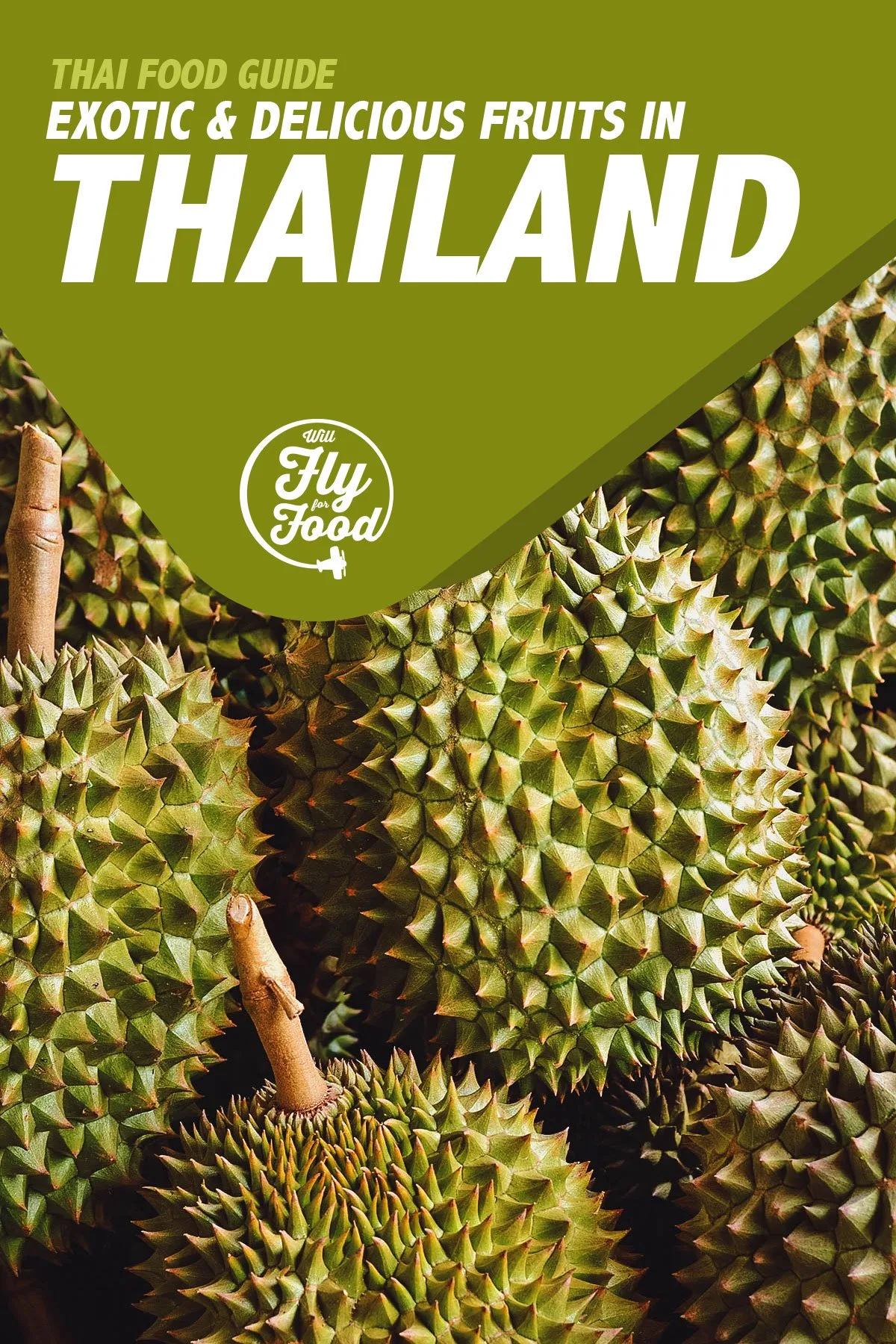
Photo by singkham
FREQUENTLY ASKED QUESTIONS ABOUT THAI FRUITS
Before we dive into this list of the most delicious and exotic Thai fruits, let’s answer a few commonly asked questions about the fruits in Thailand.
1. How many fruits are there in Thailand?
That’s a good question. We’re only familiar with the commercial varieties but according to this paper on the development of fruit production in Thailand, there are over 1,000 varieties of tropical and sub-tropical fruits in the country. A reported 57 of those fruits are grown commercially with the 6 biggest fruit crops being mango, durian, mangosteen, longan, rambutan, and lanzones.
2. What are the top 3 fruits that tourists should try in Thailand and why?
This is subjective. You can’t go wrong with any of the 6 major Thai fruit crops mentioned in the previous question but personally, I’d recommend durian, mangosteen, and lanzones. Personally, those are my three favorite Thai fruits.
3. When are the fruits in Thailand in season?
This varies from fruit to fruit but the main fruit season in Thailand is from April to July. Some fruits are available year-round though most are best at certain times of the year. To help you decide which fruits to try on your visit to Thailand, I’ve indicated under each entry when these Thai fruits are in season.
4. Where can I buy fruits in Bangkok?
Fresh fruits are available in every fresh market in Bangkok, but one of the best places to have them is at Or Tor Kor Market. Located next to the famous Chatuchak Weekend Market, it’s a more upscale food market declared by CNN and Newsweek as one of the 10 best food markets in the world.
Prices are a bit higher at Or Tor Kor but the quality is second to none. Plus, it’s cleaner and much more pleasant than your average wet market in Southeast Asia.
MUST-TRY EXOTIC THAI FRUITS
Thailand is home to many popular fruits like mango, banana, pineapple, passion fruit, and coconut. Most of you are already familiar with those fruits so we’ve left them off this list to focus on the more exotic fruits in Thailand like durian, sugar apple, dragon fruit, and rose apple.
1. Mangosteen
Personally, mangosteen is one of my favorite Thai fruits. We have them in the Philippines as well but the mangosteen in Thailand is on a different level. They’re so incredibly sweet and delicious.
Mangosteen are round Southeast Asian fruits with a leathery purple shell and soft white fruit. To eat, you cut the thick purple skin in half with a knife to reveal 5-8 segments of the delicate fruit. The largest segments will have a seed in the middle which you can spit out after eating the white flesh.
When in season, nothing beats Thai mangosteen. They’re sweet, just a little but tangy, and insanely addictive. It takes some serious will power to stop eating them!
It’s interesting to note that mangosteen is nicknamed the “queen of fruits” in Thailand. They’re commonly paired with durian, the “king of fruits”, because they’re said to have a cooling effect on the body as opposed to durian which is known to increase your body heat.
Scientific name: Garcinia mangostana
Thai name: Mangkut (มังคุด)
Mangosteen season in Thailand: April to December
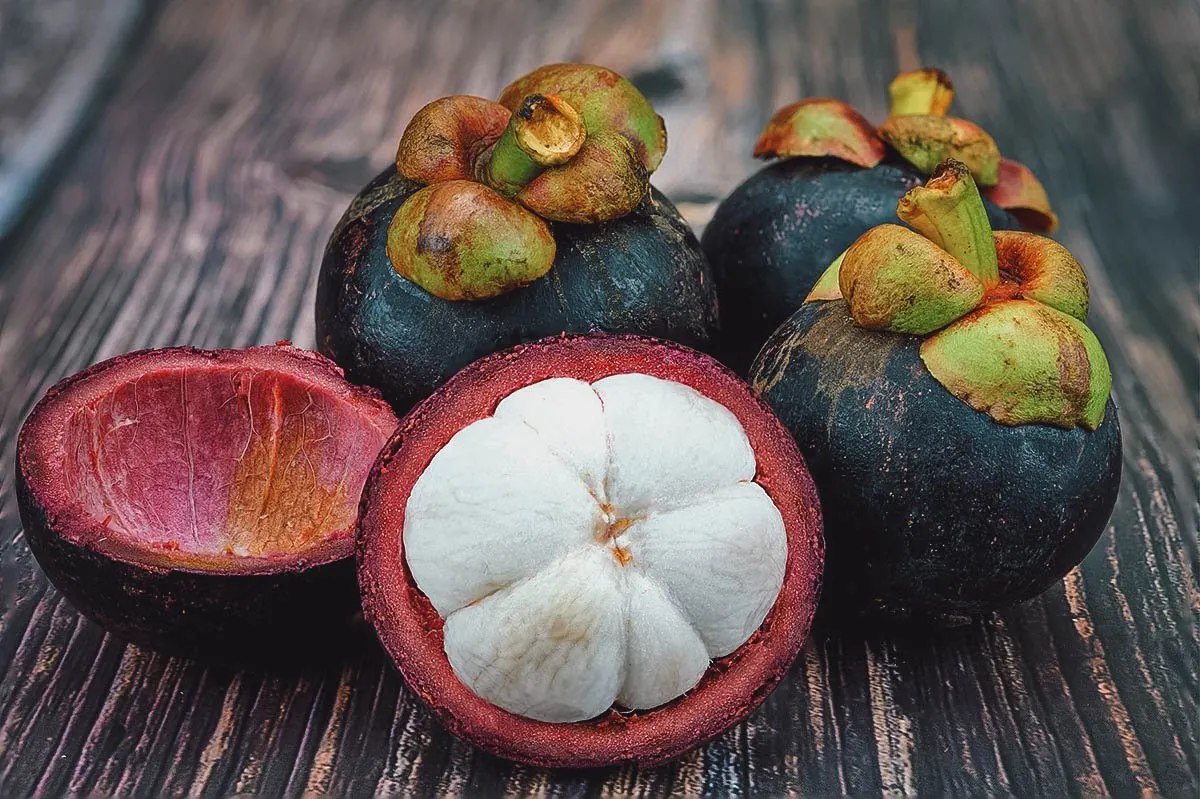
Photo by somchaichoosiri
2. Durian
The undisputed “king of fruits”, durian is perhaps the most notorious and polarizing fruit in Thailand. You either love it or you hate it. Personally, I love it and can’t get enough of it whenever we visit Bangkok. It’s the one Thai fruit that I always look for at Or Tor Kor Market.
Brownish green in color with a thorny and thick exterior rind, durian has an unrelenting stench that’s off-putting to many. Most foreigners can’t get past its smell which has been likened to rotting flesh or moldy gym socks, but the ones that do are rewarded with a sweet and silky fruit reminiscent of custard flavored with almonds.
No matter how good durian tastes, its stench is undeniable so it’s banned in many public spaces like hotels, airports, and the subway. Personally, I think it’s best when eaten ripe and straight from the rind, but people wary of the smell may want to try it in a processed form first. Durian is used as a flavoring agent in many Thai food products like candies, cakes, chips, ice cream, and coffee.
Durian can vary greatly in quality with the best brands setting you back a few hundred baht. If you want to try the raw fruit without breaking the bank, then I suggest going to Or Tor Kor Market. You can get just one or two prepackaged pieces so you don’t have to buy the whole fruit.
Scientific name: Durio zibethinus
Thai name: Turian (ทุเรียน)
Durian season in Thailand: April to August
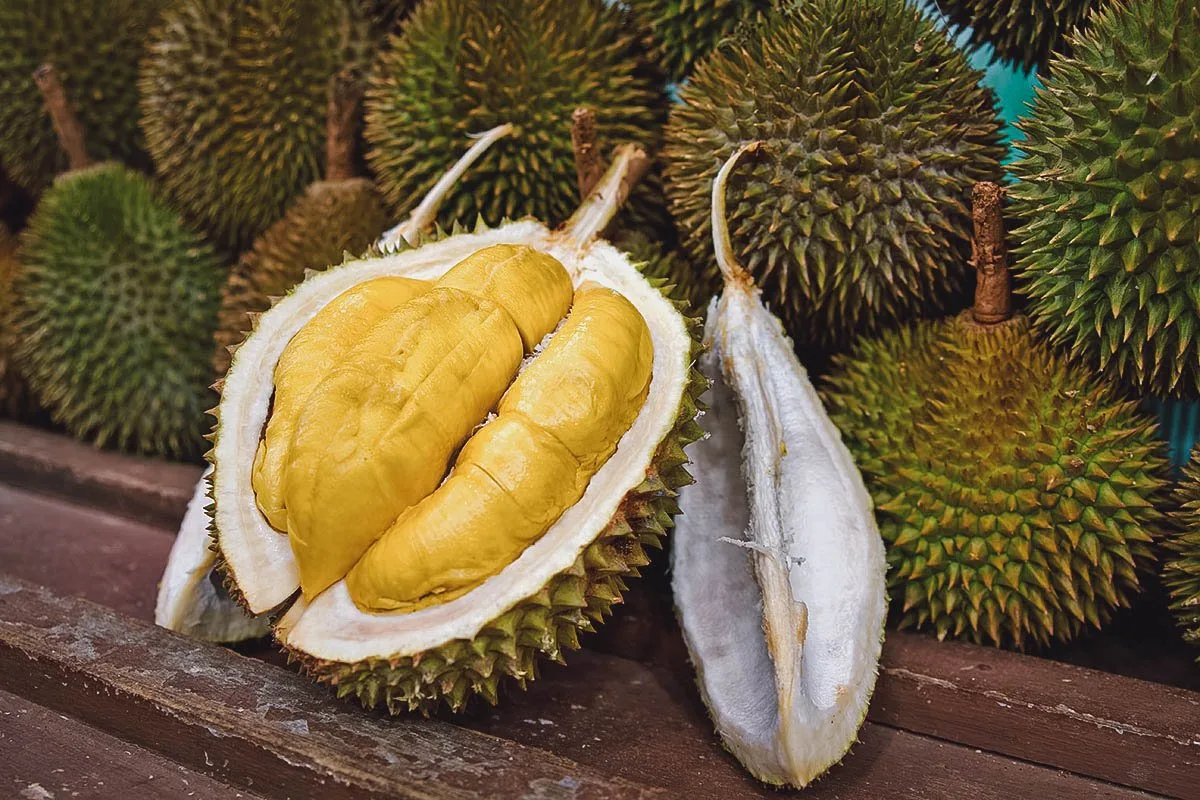
Photo by davidgn
3. Lanzones
Lanzones (or langsat, longkong) is the third of my personal big three Thai fruits. Provided they’re in season, lanzones, durian, and mangosteen are the three fruits I would always look for on every return trip to Thailand.
Lanzones is a popular Southeast Asian fruit with thin, pale brown skin and translucent flesh. Clustered like grapes, the skin is easy to break open with your fingers to reveal 4-5 segments of the sweet fruit. The smaller segments are usually sweeter while the largest segments will have a seed in the middle. You can eat the flesh around them but be careful not to bite into the seeds as they can be very bitter.
Like mangosteen, lanzones is one of those incredibly addictive Thai fruits. They may even be more addictive since they’re smaller and easier to eat. Once you start, it’s almost impossible to stop.
Scientific name: Lansium parasiticum
Thai name: Langsat (ลางสาด)
Lanzones season in Thailand: July to October
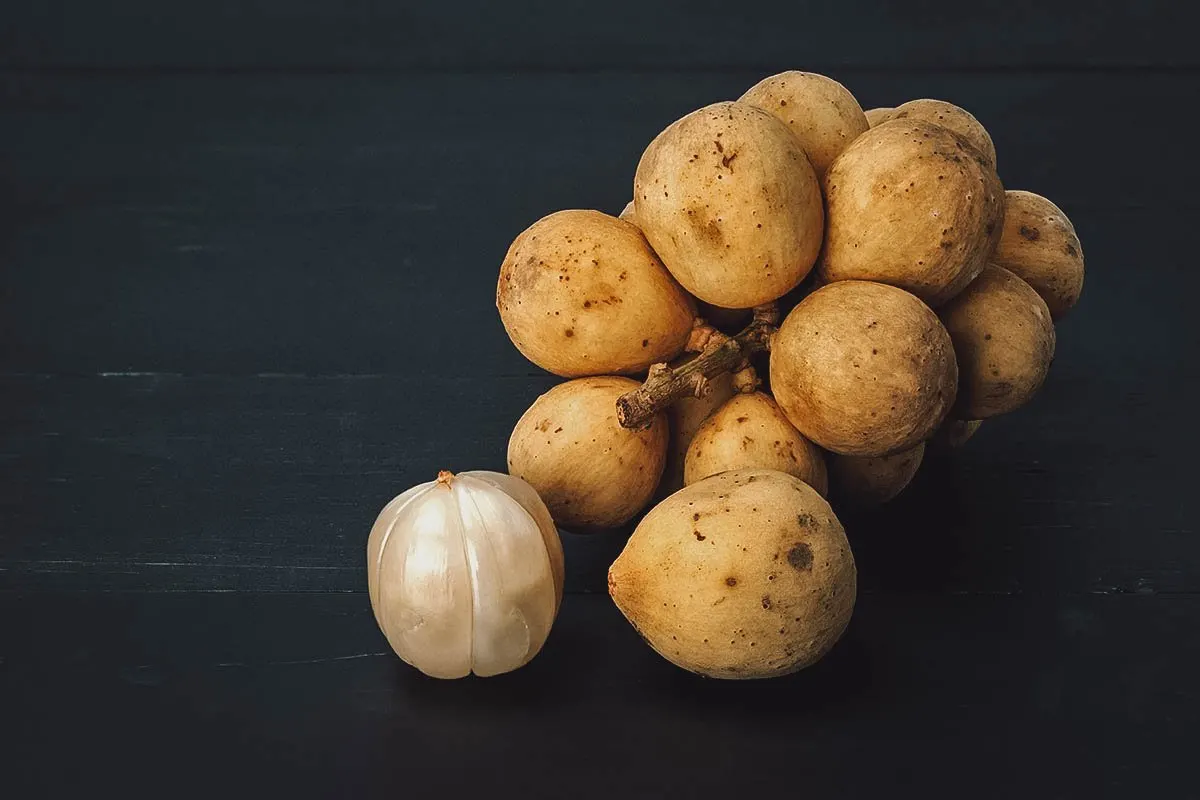
Photo by supaleka
4. Dragon Fruit
Also known as pitaya or pitahaya, dragon fruit is one of the most beautiful and unusual-looking fruits on this list. It refers to the fruit of a cactus tree cultivated throughout the tropical and subtropical regions of the world like Central America, Southeast Asia, India, and the Caribbean.
Dragon fruit is known for its distinctive reddish-purple skin with green fins or horns and a soft white flesh dotted with small crunchy black seeds. It’s very mild in its sweetness and has a texture similar to kiwi fruit. Dragon fruit can be eaten fresh with a spoon, sliced and mixed into a fruit bowl, or blended into juices.
Dragon fruit with white flesh is the most common and what you’d typically find at fresh markets in Thailand. Dragon fruit with deep purple flesh is sweeter but more rare. Even rarer still is yellow dragon fruit.
Scientific name: Selenicereus undatus
Thai name: Gao mung gorn (แก้วมังกร)
Dragon fruit season in Thailand: April to October
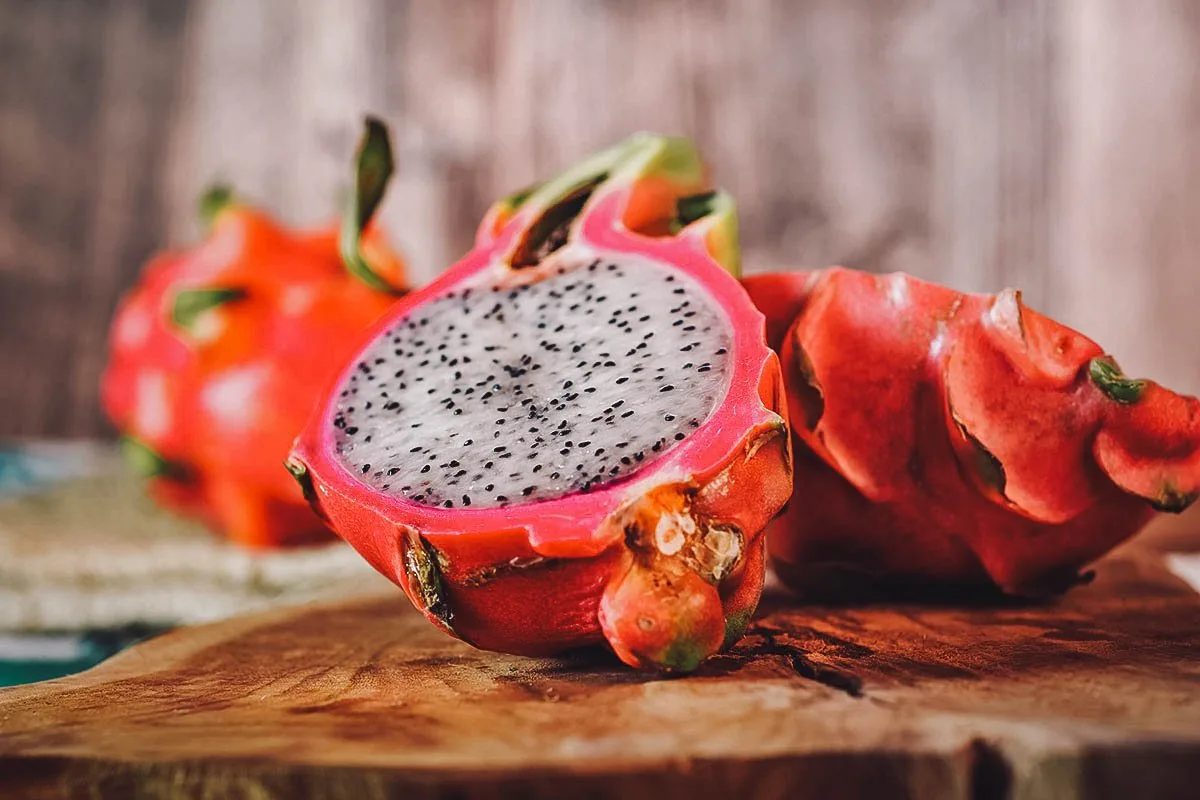
Photo by sabinoparente
5. Guava
Native to Central America and the West Indies, Thai guavas are among the most common fruits you’ll find at a sidewalk fruit stall. Available year-round, they’re about the size of an apple with white flesh and many small seeds inside. Guavas can be eaten ripe though they’re more commonly eaten raw with salt or sugar mixed with dried chili.
Interestingly, the Thai word for guava is “farang”, which is the same word used to describe foreigners. No one really knows the reason for this but it may stem from the fact that guavas were introduced to Thailand by European traders sometime in the 17th century.
PRO TIP: You may come across farang that seem unnaturally bright green in color. These may have been dipped in a sugar dye solution so it’s best to avoid them and buy more normal-looking guavas from a reputable fruit shop.
Scientific name: Psidium guajava
Thai name: Farang (ฝรั่ง)
Guava season in Thailand: Year-round
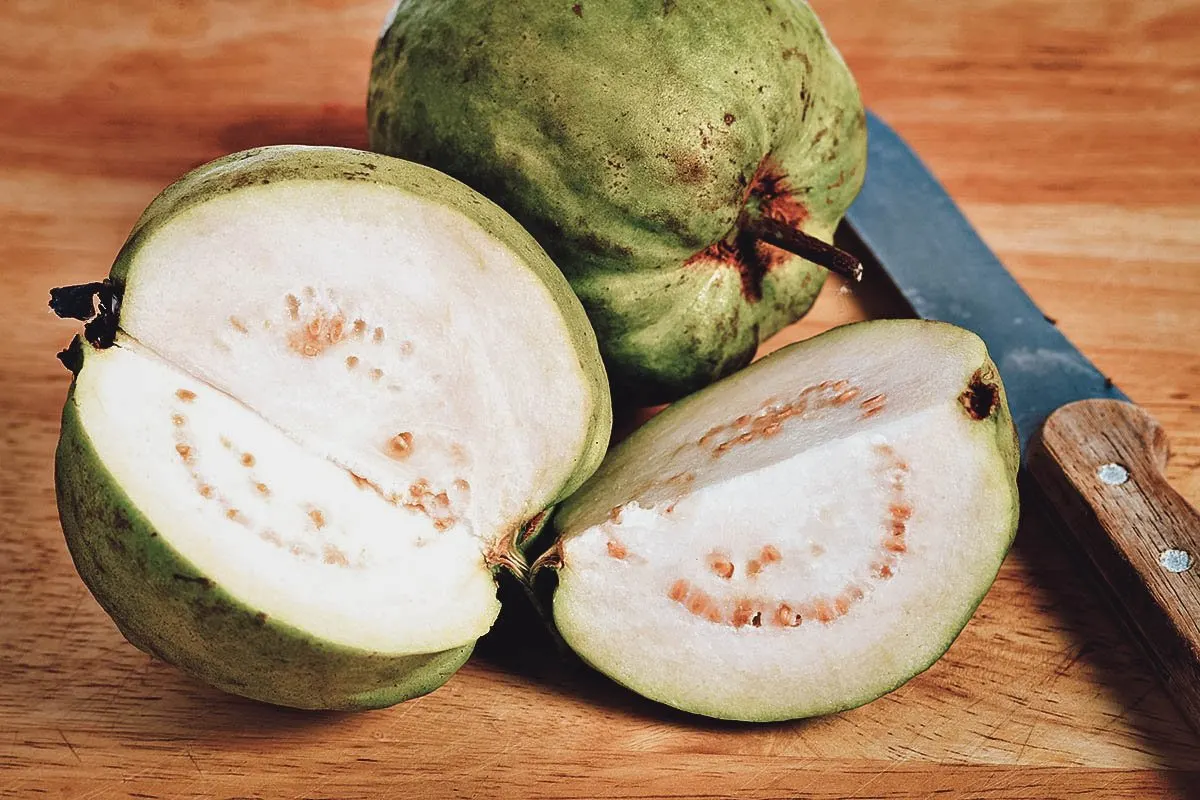
Photo by Paul_Cowan
6. Pomelo
The pomelo (or pummelo) is the principal ancestor of the grapefruit. It’s a large citrus fruit with a thick rind and pale yellow to orange or dull red flesh. Juicy, sweet, and sour, it tastes similar to grapefruit but without any of its characteristic bitterness.
Pomelo is typically eaten fresh with salt, sugar, and chili flakes, though it’s also common to find it incorporated in Thai dishes like yum sum-o (ยำส้มโอ), a spicy salad made with pomelo, coconut milk, and shrimp.
Scientific name: Citrus maxima
Thai name: Som-O (ส้มโอ)
Pomelo season in Thailand: Year-round
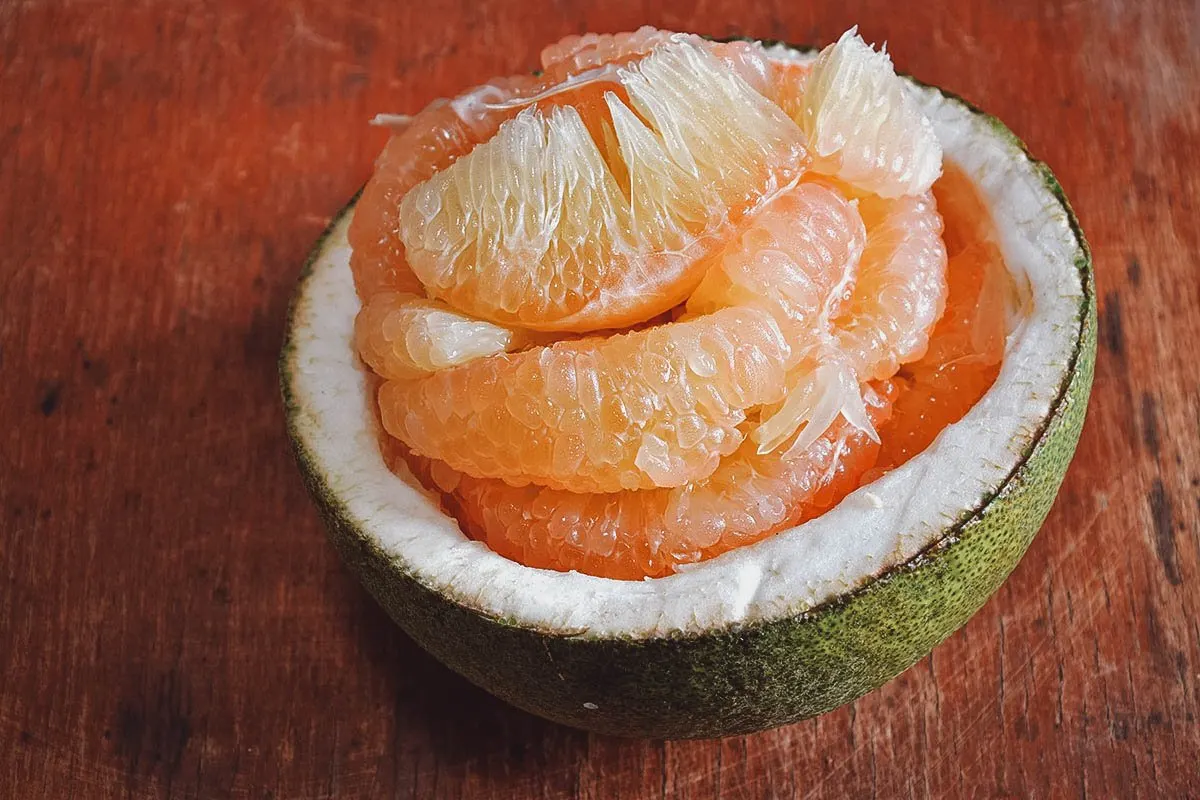
Photo by pedphoto3pm
7. Tamarind
Tamarind refers to the curved, pod-like fruit of a leguminous tree native to tropical Africa. It’s now cultivated in many parts of the world, including Thailand where it exists in two versions – sour and sweet.
Sour tamarind grows everywhere in Thailand and is often used as an ingredient in chili sauces and popular Thai dishes like pad thai and tom yum. This popular fruit ranges in sourness from sweet-and-sour to mouth-puckeringly sour and can be turned into a variety of candies, snacks, and drinks.
One of my favorite Thai tamarind candies is made with the sticky fruit removed from its exterior rind and rolled in a mixture of sugar, salt, and crushed chili. It’s a mouthwatering and highly addictive combination of sweet, sour, salty, and spicy!
Sweet tamarind is considerably more rare than the sour variety and is grown only in certain parts of Thailand like Phetchabun province. They’re much more expensive but worth every baht. Before I tasted them, I didn’t like fresh tamarind but the sweet variety changed my mind. They’re surprisingly sweet and without a trace of sourness.
Scientific name: Tamarindus indica
Thai name: Makam (มะขาม)
Tamarind season in Thailand: November to February (sweet tamarind), Year-round (sour tamarind)
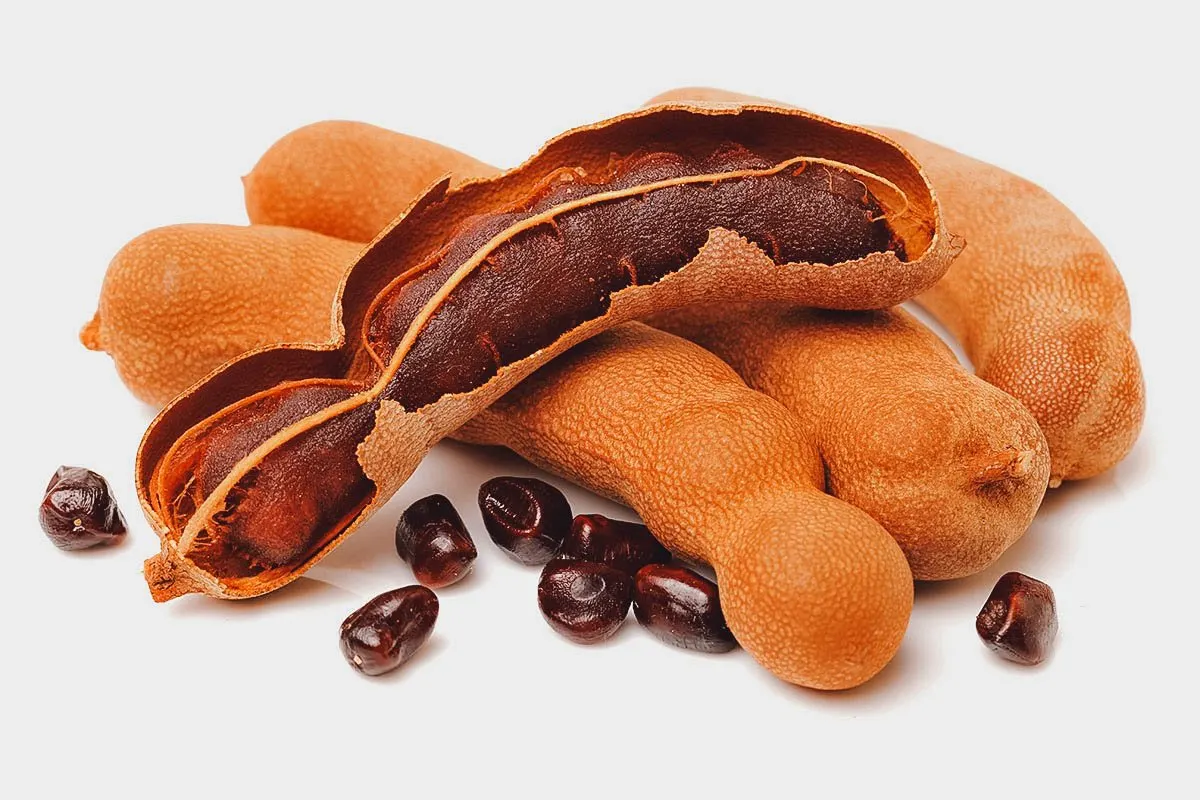
Photo by jianghongyan
8. Santol
Santol is a tropical fruit native to Malesia. Round in shape and about the size of an apple, it has a translucent to white pulp that can range in flavor from sour to very sweet, depending on the maturity and variety of the fruit. Santol is also known as cotton fruit in reference to the soft and juicy but cotton-like consistency of its pulp that can be difficult to separate from the seeds.
In Thai cooking, unripe santol is a key ingredient in som tam (ส้มตำ) or Thai papaya salad. It’s also used in other Thai dishes like santol and pork (แกงหมูกระท้อน) and santol and prawn curries (แกงคั่วกระท้อนกุ้ง).
Scientific name: Sandoricum koetjape
Thai name: Krathon (กระท้อน)
Santol season in Thailand: April to August
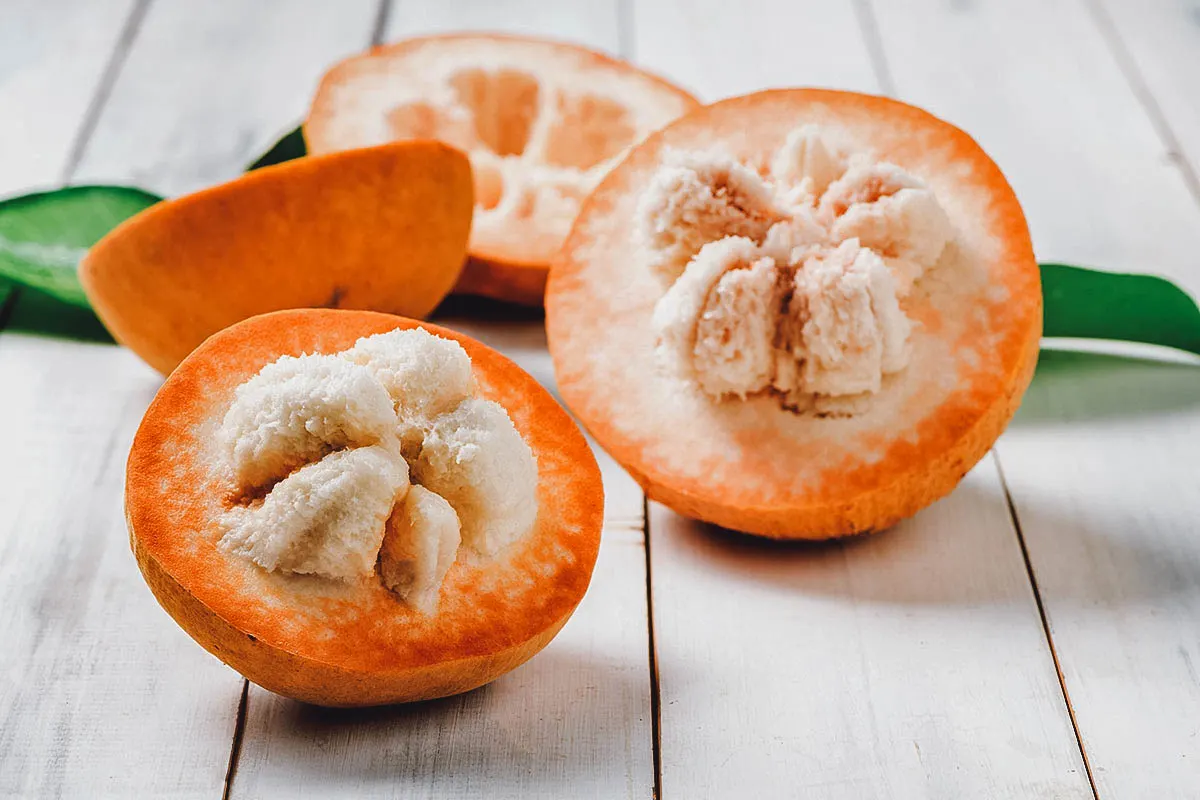
Photo by kwanchaichaiudom
9. Rambutan
Like dragon fruit, rambutan is one of the more eye-catching Thai fruits on this list. Its name is derived from the Malay word rambut, meaning “hair”, and is in reference to the green hair-like spikes covering its bright red rind.
Rambutan is closely related to lychee and longan, the next two fruits in this Thai fruit guide. It’s good but personally, my least favorite of the three. It has the thickest rind and its flesh usually isn’t as sweet as the other two. Plus, it’s the hardest to separate from the seed.
Scientific name: Nephelium lappaceum
Thai name: Ngor (เงาะ)
Rambutan season in Thailand: May to September
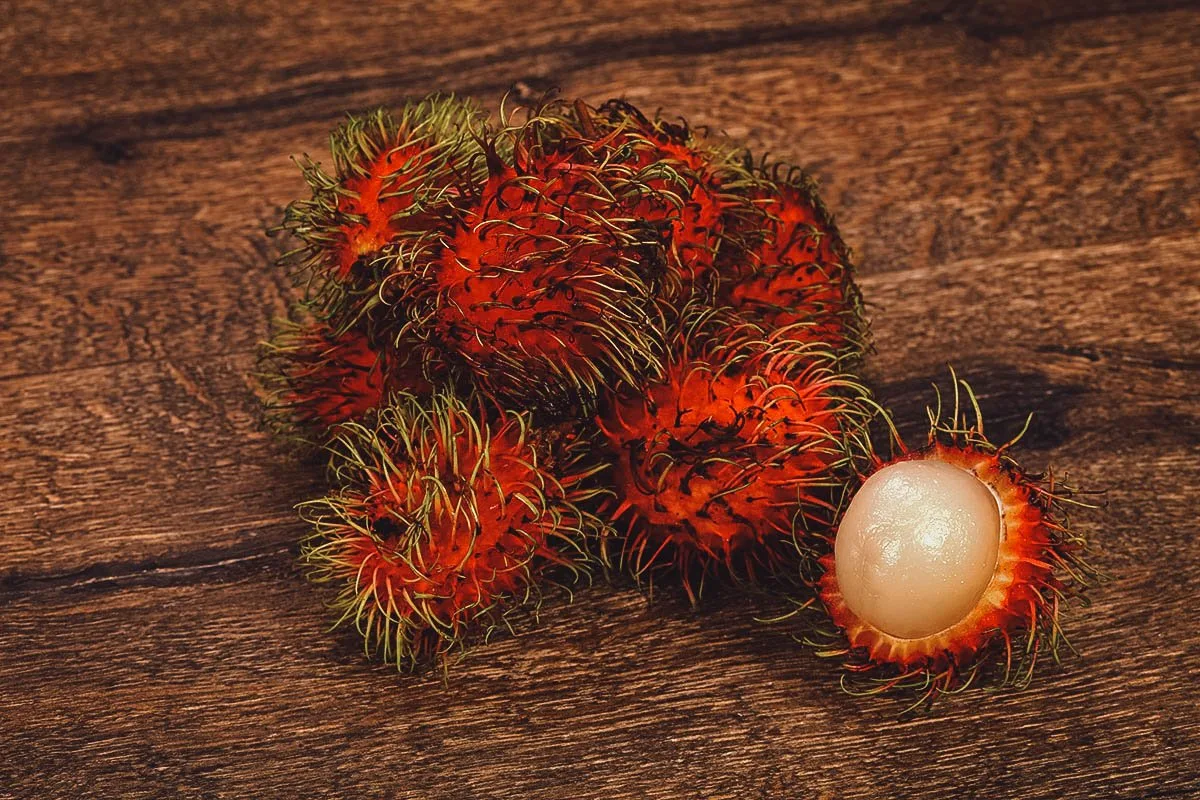
Photo by AndreySt
10. Longan
Longan is the lesser known cousin of rambutan and lychee but it’s the sweetest and my favorite of the three. It has a thin pale brown skin that you can easily break with your fingers to get to the deliciously sweet and juicy fruit inside. To eat, you pop the whole thing in your mouth and spit out the seed. Unlike rambutan, it takes little effort to separate the fruit from its seed.
Longan is cultivated in the Chiang Mai region of northern Thailand. Interestingly, its name means “dragon eye” in Cantonese and refers to the eyeball-like appearance of the shelled fruit. The flesh is translucent so you can see the big black seed inside, like a sweet and juicy eyeball.
Like mangosteen and lanzones, longan is one of those Thai fruits that you can just eat forever. It’s that good.
Scientific name: Dimocarpus longan
Thai name: Lamyai (ลำไย)
Longan season in Thailand: June to August
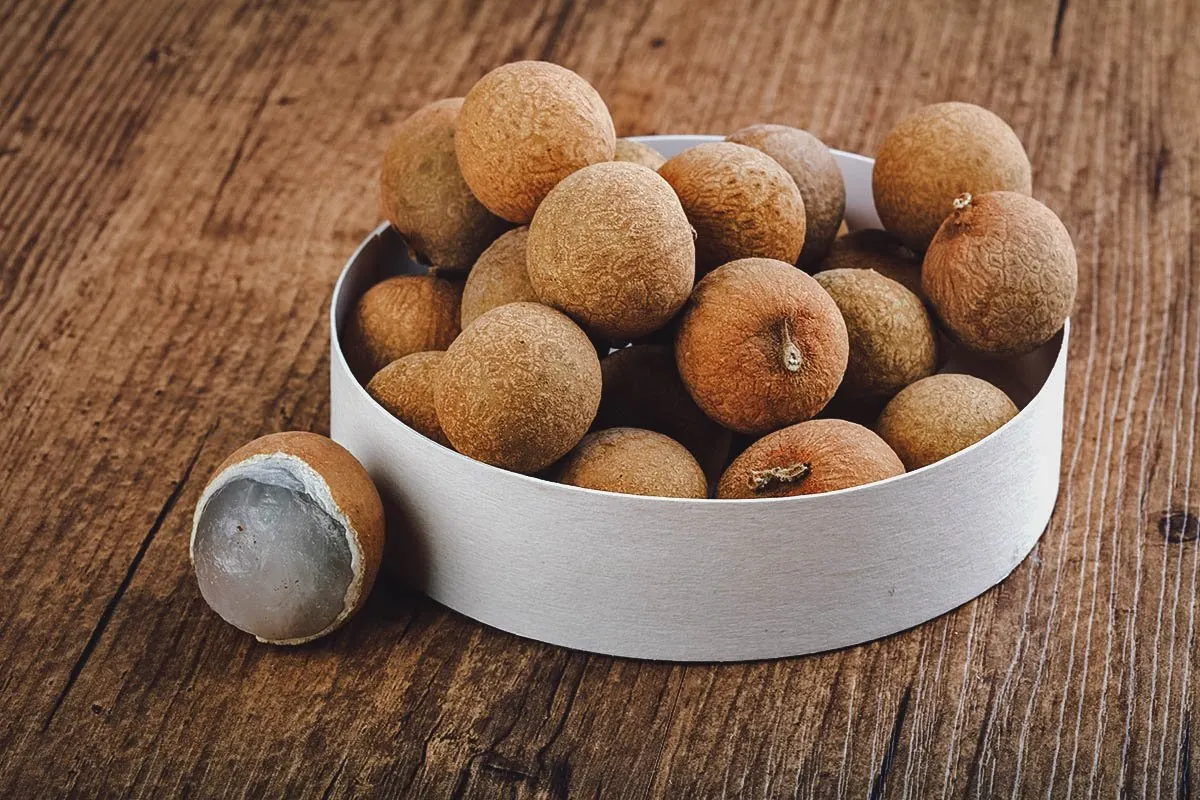
Photo by AndreySt
11. Lychee
The lychee is somewhere between a rambutan and longan. They’re slightly bigger than longan with a similarly thin but rough red skin that’s easy to break with your fingers. The fruit is deliciously sweet, though perhaps not as sweet as longan, with a smooth texture that’s easy to separate from the seed.
Lychee is native to Guangdong and Fujian provinces of southeastern China where they’ve been cultivated at least as early as the 11th century. You need to try the fresh fruits but you may want to try canned versions as well. They’re submerged in sweet syrup and used as an ingredient in desserts like bananas and lychees in coconut milk.
Scientific name: Litchi chinensis
Thai name: Linjee (ลิ้นจี่)
Lychee season in Thailand: April to June
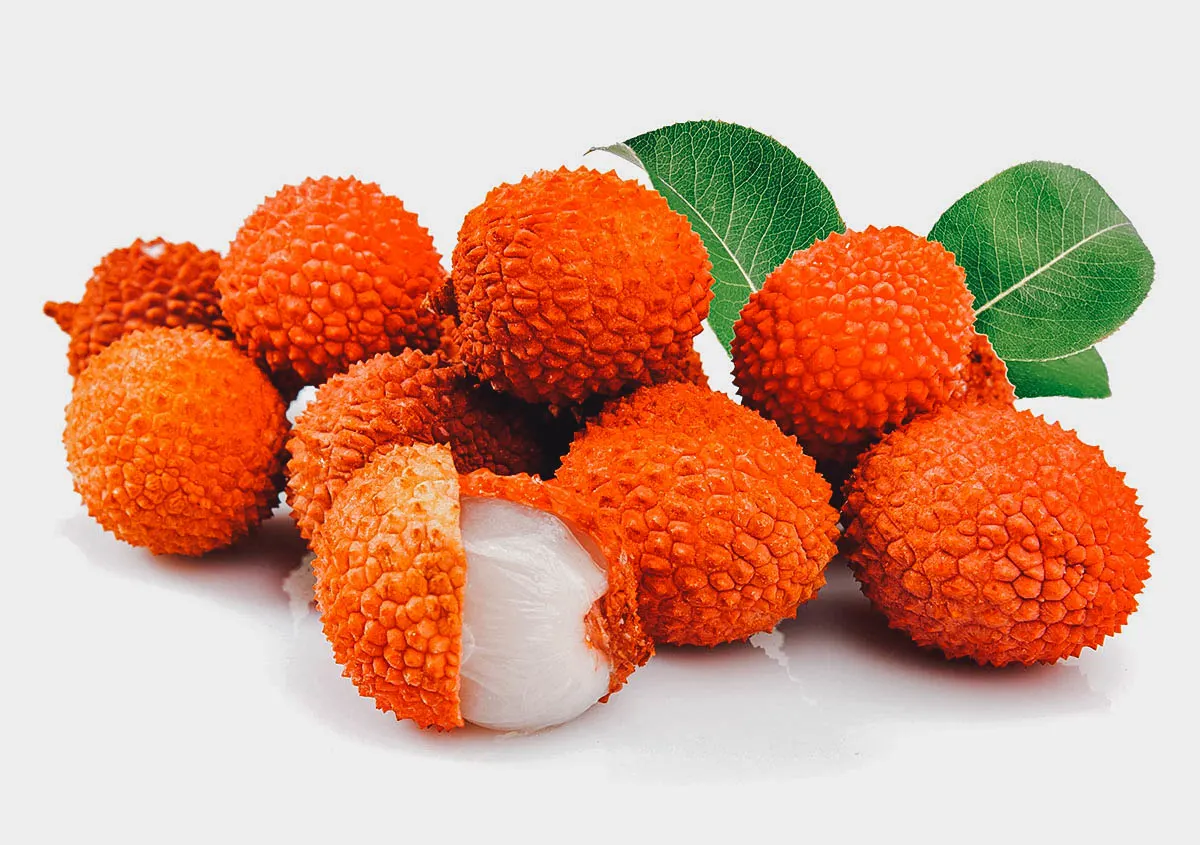
Photo by nanka-photo
12. Sugar Apple
The sugar apple is one of my favorite Thai fruits. It’s about the size of a tennis ball and known for its distinctive knobby green skin. When ripe, you can easily split the fruit in half with your hands to reveal dozens of fleshy white segments inside, most of which contain a seed.
Sugar apple is best eaten with a spoon. You scoop up spoonfuls of the fleshy segments and put them in your mouth all at once. The fruit has a creamy texture that separates easily from the seeds which you can then spit out one by one.
Sugar apple is also referred to as custard apple or sweetsop because the the fruit tastes much like creamy custard. It’s absolutely delicious, especially when refrigerated.
Scientific name: Annona reticulata
Thai name: Noina (น้อยหน่า)
Custard apple season in Thailand: June to September
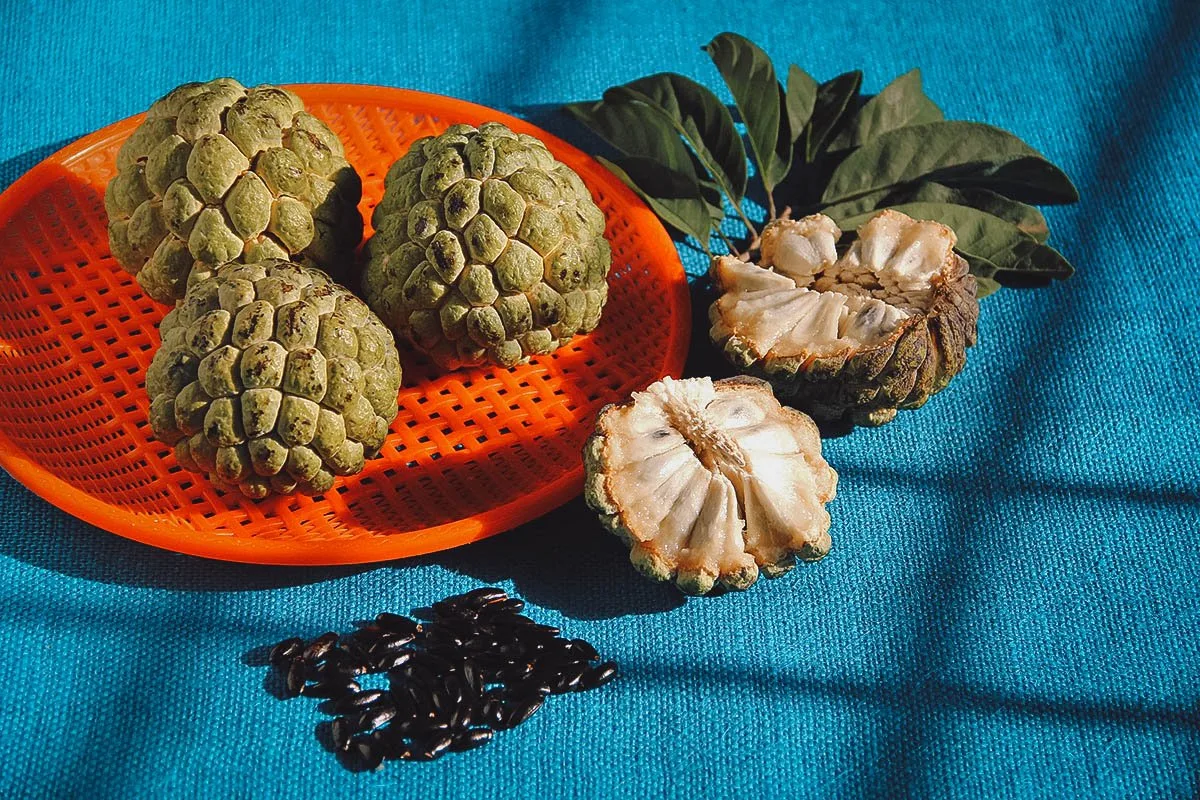
Photo by RealityImages
13. Salak (Snake Fruit)
Salak refers to a species of palm tree native to Java and Sumatra in Indonesia. Its fruit is commonly referred to as “snake fruit” because of the scaly pattern on its hard, prickly reddish-brown shell. From a distance, it really does resemble the head of a snake.
Snake fruit can be a bit difficult to peel but persistent tourists will be rewarded with a slightly sweet and tart pulp that’s dry and crunchy. It’s commonly eaten raw and dipped in a mixture of salt and sugar.
Scientific name: Salacca zalacca
Thai name: Sala (ระกำ)
Snake fruit season in Thailand: June to September
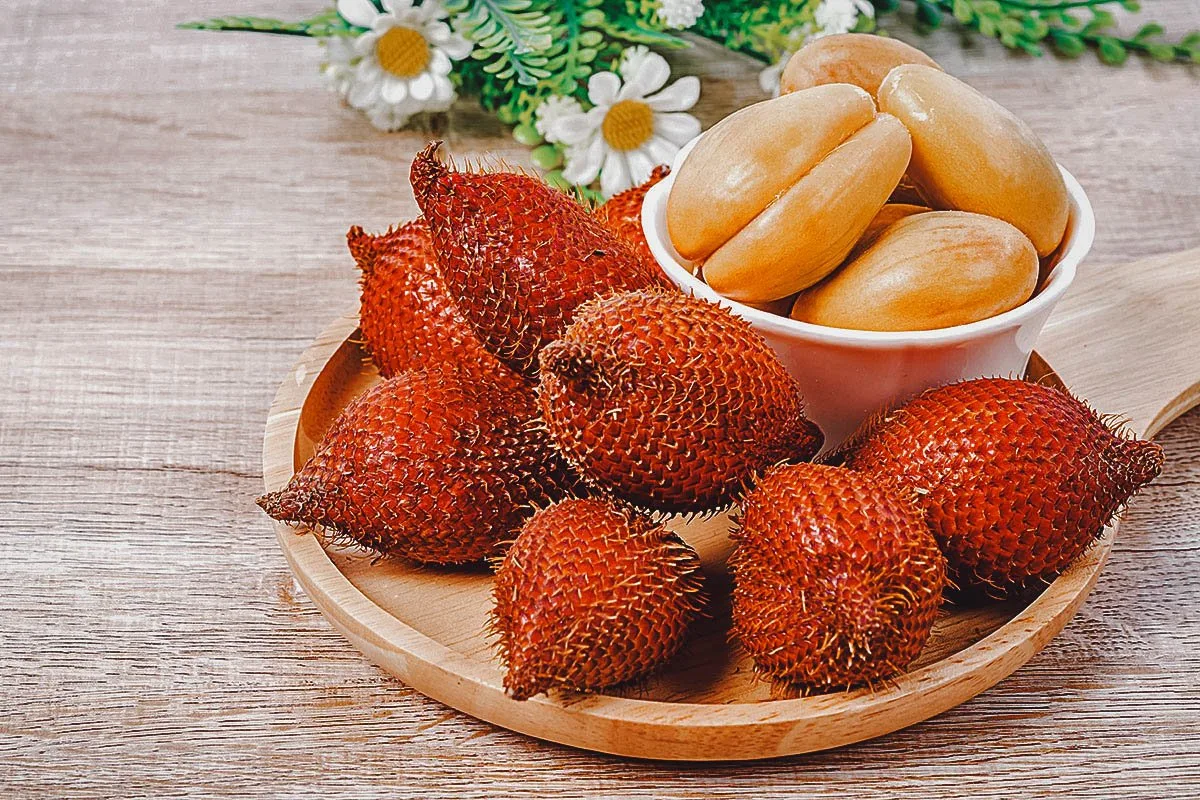
Photo by gamjai
14. Rose Apple
Rose apple (or wax apple, rose pear, mountain apple) refers to the fruit of a flowering tree native to Malesia and Australia. Bell-shaped and waxy in appearance, rose apples can be bright red or light green with a crunchy texture reminiscent of apples or pears, but juicier. In Thailand, the version of rose apple with green skin is more common.
Rose apples are a slightly sweet fruit often eaten raw with salt and sugar. They’re also one of the main ingredients in a Thai spicy salad (ยำชมพู่) made with dried shrimp and chili peppers.
Scientific name: Syzygium malaccense
Thai name: Chompoo (ชมพู่)
Rose apple season in Thailand: Year-round
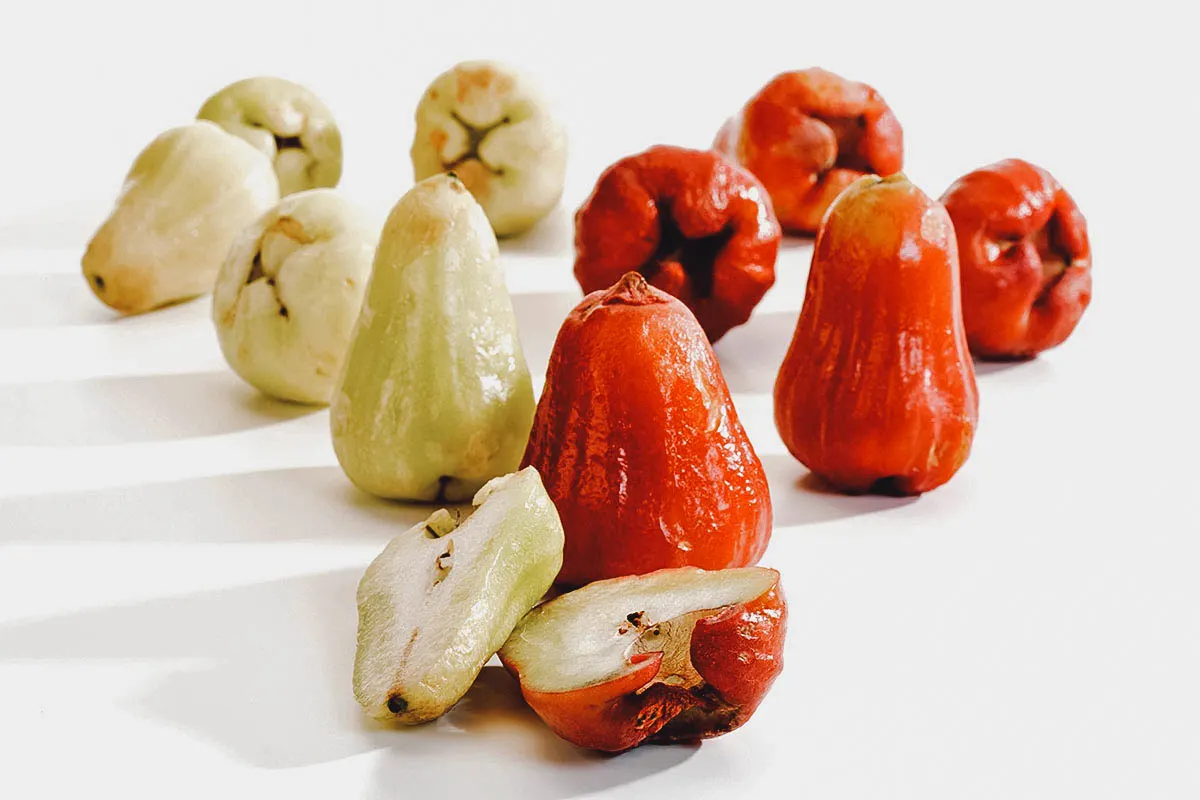
Photo by imagebrokermicrostock
15. Jackfruit
Growing up to 3 ft (91.5 cm) long and weighing in at 80 lbs (36 kg), the jackfruit is a large fruit that’s every bit as delicious as it is versatile. It consists of a thick bumpy rind which when broken open reveals dozens of yellow waxy segments, each containing a seed.
Jackfruit tastes sweet but not too sweet. It’s relatively dry with a robust texture that’s crunchy when eaten raw, but almost meat-like when cooked. For me, jackfruit is best when eaten fresh, but like lychees, it’s commonly canned in sugar syrup and used in desserts like ruam mit (รวมมิตร), a Thai dessert made with shreds of coconut and jackfruit in coconut milk.
Jackfruit is also commonly dried and made into chips and used as an ingredient in savory dishes like Thai curries. Thanks to its meaty texture and neutral taste, it makes for an excellent meat substitute.
Scientific name: Artocarpus heterophyllus
Thai name: Kanoon (ขนุน)
Jackfruit season in Thailand: January to May
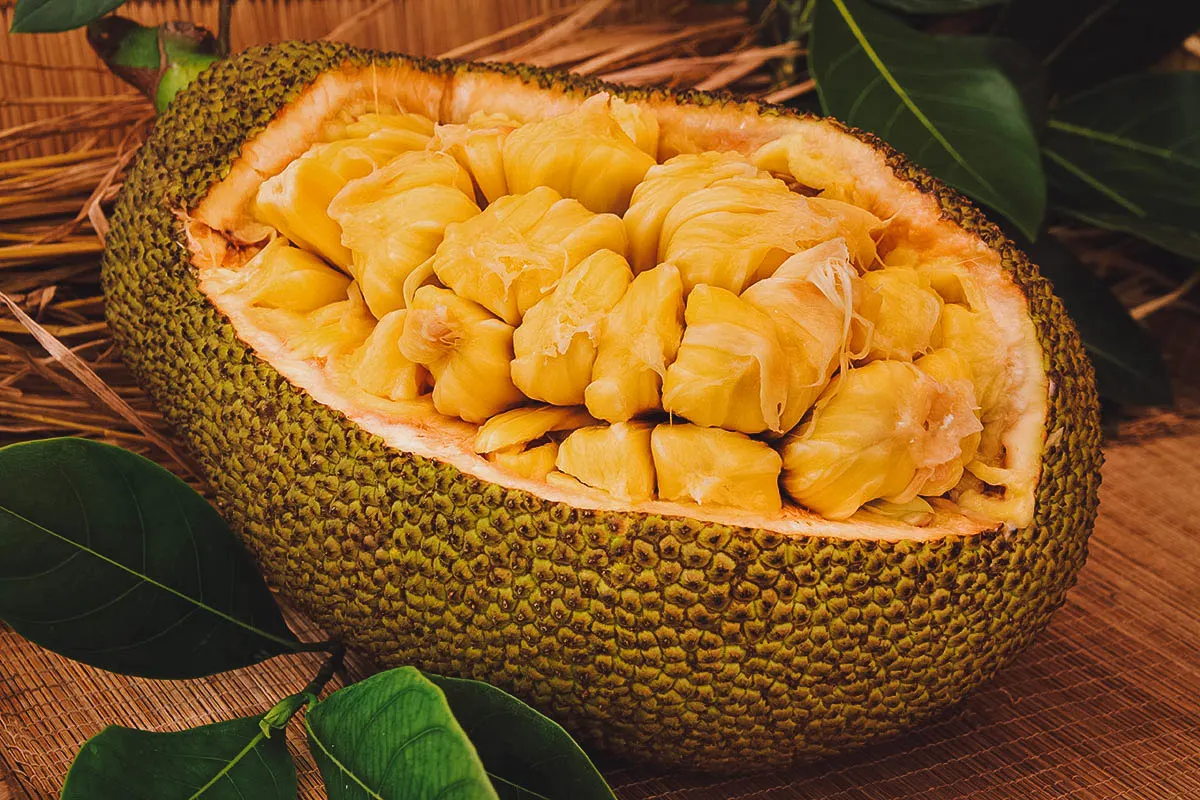
Photo by anasta.see.you.yandex.com
16. Star Fruit
The common name of this next Thai fruit isn’t obvious until you slice it. Also known as carambola or 5 fingers, these distinctively-shaped fruits have five ridges that run along its sides. When sliced across, the cut segments resemble little stars.
When eaten ripe, star fruits are crunchy, firm, and very juicy. They’re just slightly sweet with tart, sour undertones, similar to apples or pears. Star fruits are usually eaten raw but they can be made into juices, relishes, and preserves.
Scientific name: Averrhoa carambola
Thai name: Ma fueng (มะเฟือง)
Star fruit season in Thailand: October to December
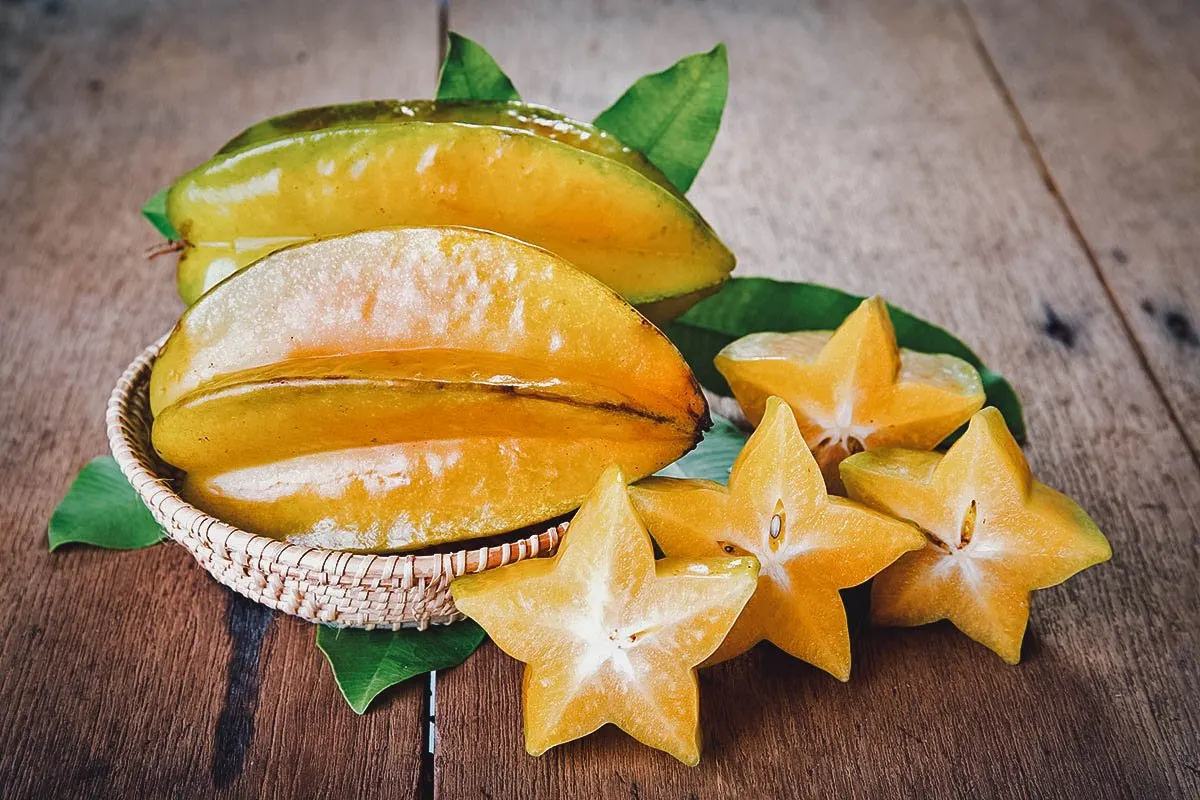
Photo by sirikornt
17. Gac
When I first saw gac at a fruit stall in Phuket, I thought it was fake. Covered in small thorns, it has an intense reddish-orange skin that looks almost like plastic. I remember being so befuddled by this exotic fruit that I had to ask the vendor if it were real. She confirmed it was and sold me a bottle of gac juice, which was absolutely delicious.
A less common Thai fruit, gac is a type of melon that grows throughout Southeast Asia and northeastern Australia. When eaten raw, it has a dense but mild-tasting flesh rich in beta-carotene and lycopene. Based on what I’ve read, it seems to be a fruit that’s best enjoyed as juice rather than eaten fresh.
Scientific name: Momordica cochinchinensis
Thai name: Fak khao (ฟักข้าว)
Gac season in Thailand: December to January
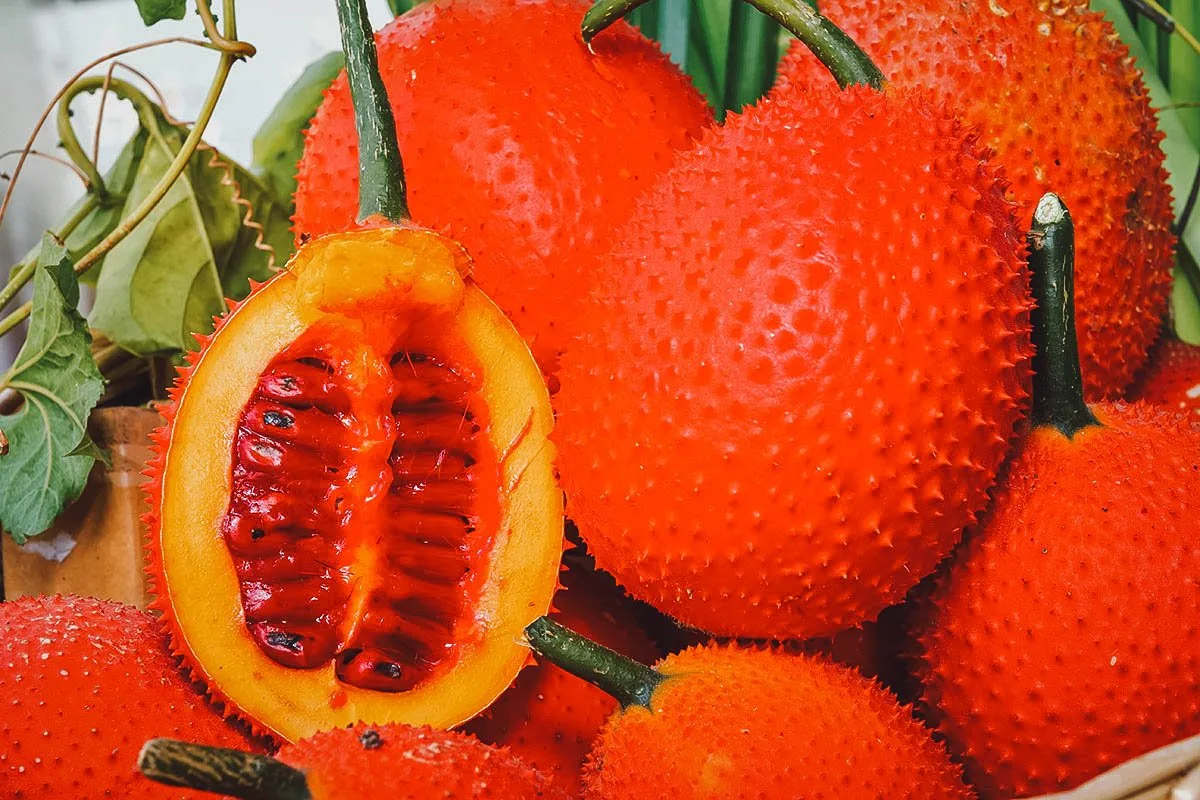
Photo by Praiwun
18. Hog Plum
The hog plum is a fruit native to the tropical Americas. Like guava, it was introduced to Asia by the Portuguese and has since become naturalized in parts of South Asia, Southeast Asia, and Africa. When eaten ripe, they have a sharp, somewhat acidic taste similar to Granny Smith apples.
Hog plums can be eaten fresh or made into juices, concentrates, and jellies. In Thai cuisine, the fruit is used as a secondary ingredient in som tam (Thai papaya salad) while the leaves are sometimes served with certain types of nam prik (น้ำพริก) or Thai chili paste.
Scientific name: Spondias mombin
Thai name: Makok (มะกอก)
Hog plum season in Thailand: July to September
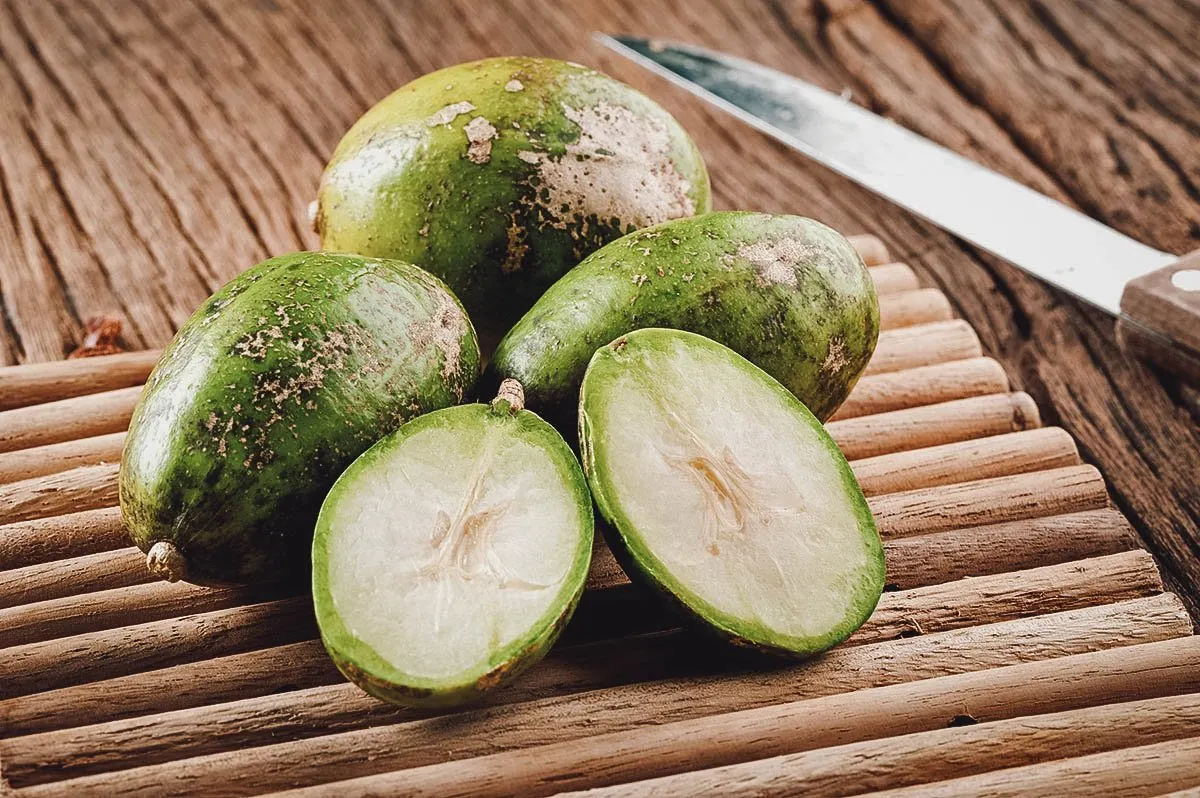
Photo by norgallery
19. Chico
Chico may not be as pretty as dragon fruit but it’s just as worthy of a spot on this Thai fruit guide. Also known as sapodilla or chikoo, it refers to a fruit that’s native to Mexico, Central America, and the Caribbean but is now cultivated in large quantities throughout Southeast and South Asia.
Resembling a potato more than fruit, chico is an oval-shaped Thai fruit with dull mud-brown skin. It’s unattractive exterior belies a pear-like flesh that’s sweet and malty in flavor. Its pulp is soft and juicy with a slightly gritty though not unpleasant texture.
Scientific name: Manilkara zapota
Thai name: Lamut (ละมุด)
Chico season in Thailand: September to December
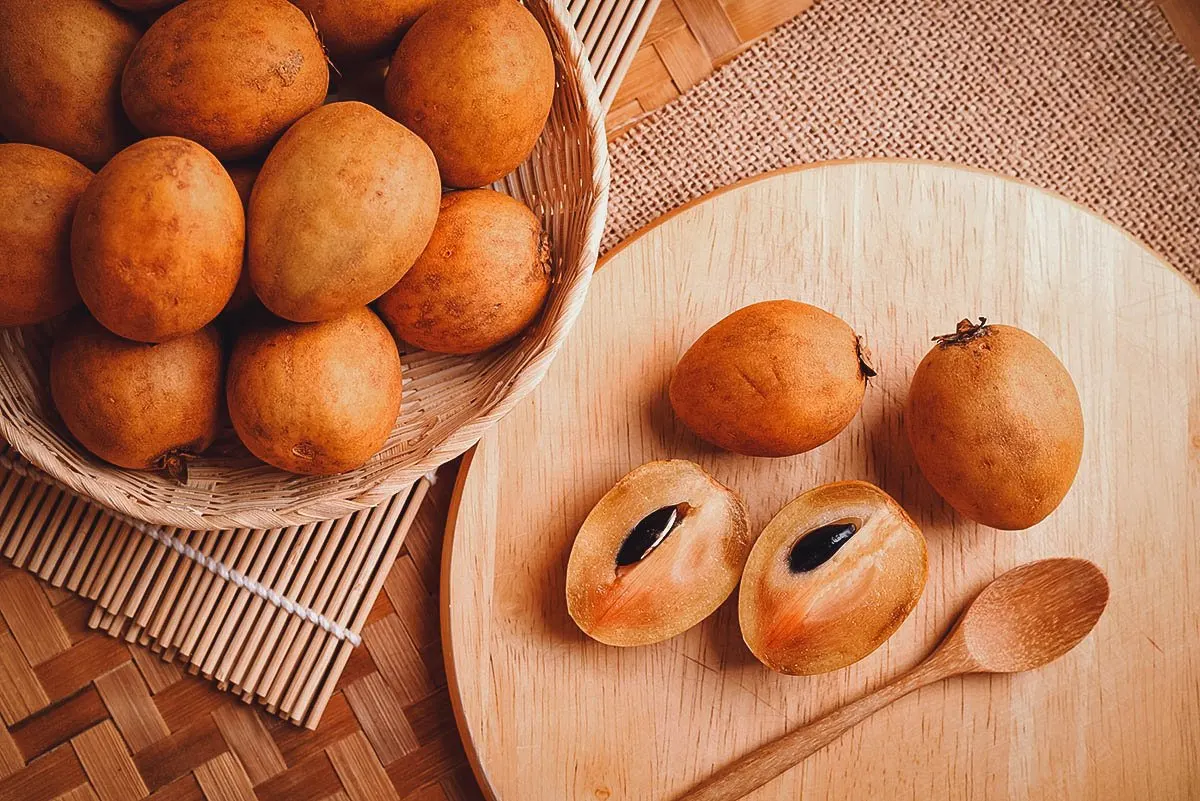
Photo by nungning20
20. Plum Mango (Marian Plum)
No, this isn’t the same sweet mango used to make that delicious Thai dessert with coconut milk and sticky rice. Commonly known as marian plum or plum mango, it belongs to the same family of fruits as mangoes and cashews but is a different fruit altogether.
The marian plum looks like a small ripe mango but its smell and taste are different. When cut open, its bright orange flesh releases a mango-like fragrance with a hint of turpentine. Soft, jelly-like, and slightly fibrous in texture, marian plum flesh tastes sweet and similar to mangoes but is much more acidic in flavor. They can be eaten raw as is, with or without the skin, or mixed into Thai fruit salads.
Scientific name: Bouea macrophylla
Thai name: Maprang (มะปราง)
Plum mango season in Thailand: April to May
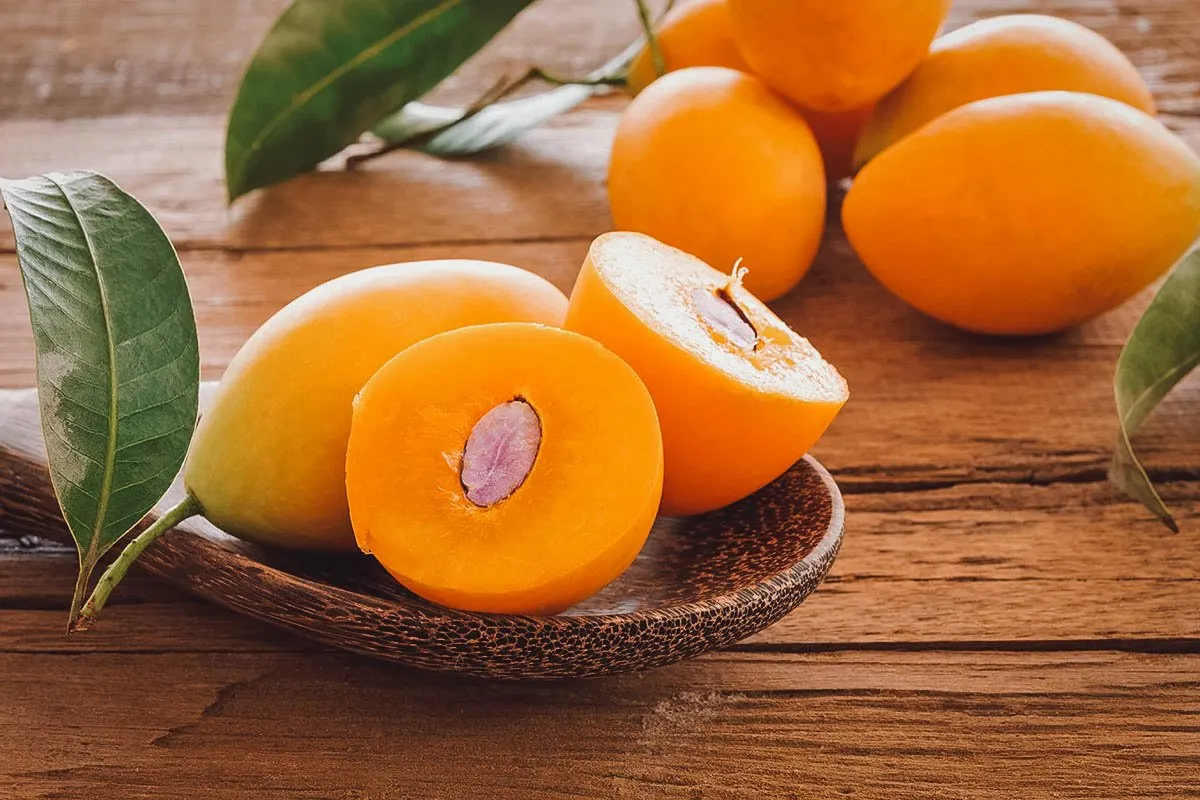
Photo by utah778
THAI FOOD TOURS
If you’re reading about Thai fruits, then it’s safe to assume you have an interest in Thai food in general. If you’re visiting Thailand and looking to really dive into the cuisine, then you may be interested in booking a food tour. Not only will a Thai guide take you to the city’s best restaurants, markets, and street food stalls, but they’ll be able to explain all the dishes in more detail as well.
Check out Get Your Guide for a list of Thai food tours in Bangkok, Chiang Mai, Phuket, and other popular tourist destinations throughout the country.
THAI COOKING CLASSES
Eating mango sticky rice with coconut milk is one thing, but learning how to make it yourself is another. In my opinion, there’s no better way to learn about the local cuisine than by taking a cooking class.
We’ve taken cooking classes in many cities around the world, including Phuket and Chiang Mai, and have enjoyed them all. Check out Cookly for a list of cooking classes in Thailand.
FINAL THOUGHTS ON THAI FRUITS
I hope you enjoyed reading this Thai fruit guide as much as I enjoyed writing it. I absolutely love Thai fruits and think it’s one of the best reasons to visit Bangkok. It’s something we always look forward to on every return trip to Thailand.
If you want more suggestions on what to eat in Thailand, then be sure to check out our Thai food guide as well. Thanks for reading and have an amazing time eating all the delicious and exotic fruits in Thailand!
Disclosure
Some of the links in this article on Thai fruits are affiliate links, meaning we’ll get a small commission if we make a sale at no added expense to you. We only recommend products and services that we use ourselves and firmly believe in. We really appreciate your support as this helps us make more of these free travel guides. Thank you!
Featured photo by seagamess. Stock images via Depositphotos.


Al
Thursday 4th of May 2023
I've been in Thailand twice,I'm a fruit lover and mainly I've tried many of these fruits. You have given an amazing information about the seasons and native names and their specifications. Very informative.
JB & Renée
Sunday 21st of May 2023
Happy you appreciated it Al!
Mike
Wednesday 22nd of February 2023
This is very helpful! In Thailand (Chiang Mai) now and desperately trying to figure out all of these fabulous fruits. Might have to try a cooking class before we leave!
JB & Renée
Wednesday 29th of March 2023
Have an awesome time Mike! We're in Thailand ourselves right now. Cooking classes are always fun. Enjoy!
Robert
Saturday 31st of December 2022
Such an Inspiration, and informative as well, thank You!!! Go for apricots and plumbs when coming to Austria, and enjoy the desserts "Marillenknödel" und "Kaiserschmarrn"! Best wishes from Vienna, austria, rob
JB & Renée
Thursday 12th of January 2023
Thank you Rob! We'll definitely make our way to Austria soon. :)